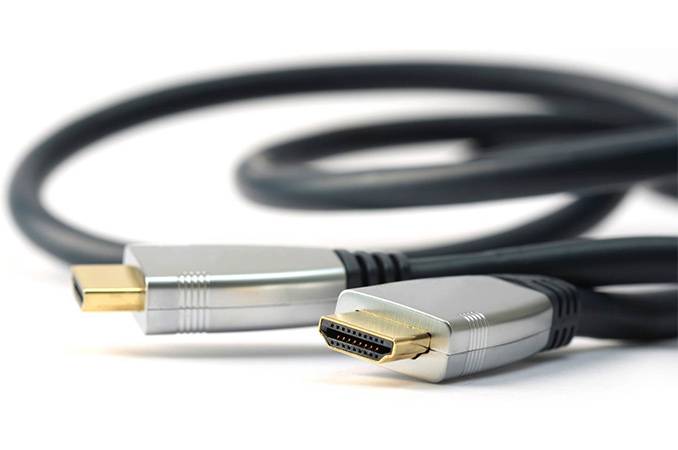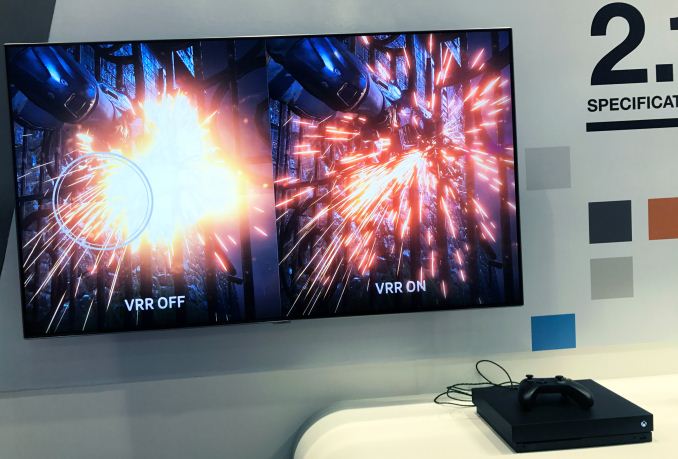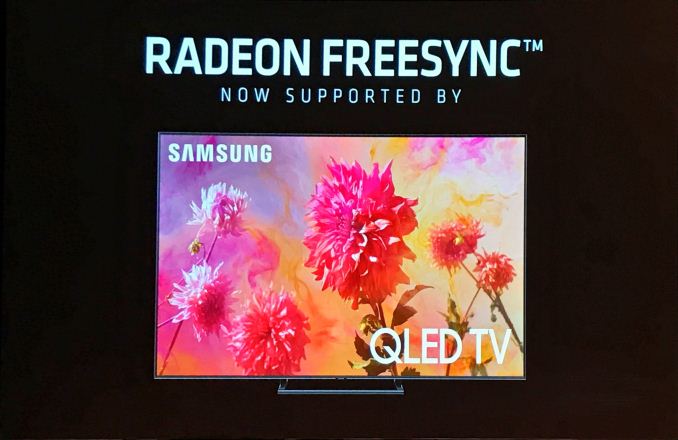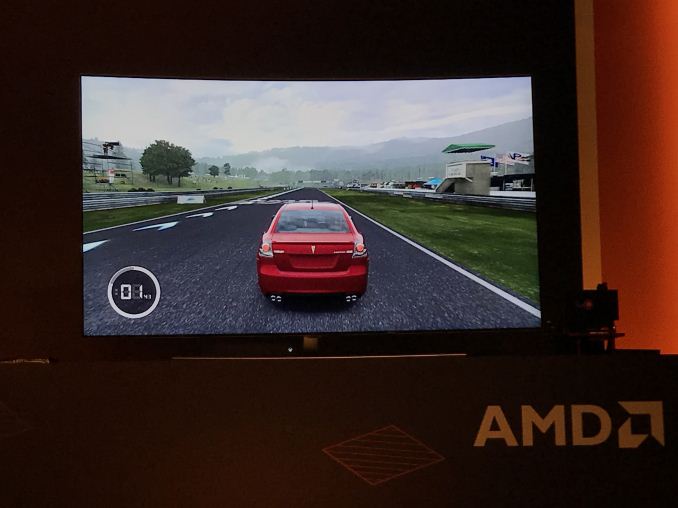HDMI Forum Demonstrates HDMI 2.1 VRR Capabilities on Samsung TV
by Anton Shilov on June 20, 2018 3:00 PM EST- Posted in
- GPUs
- AMD
- Microsoft
- HDMI
- FreeSync
- Xbox One X
- Computex 2018
- VRR
- HDMI 2.1

Dynamic refresh rate technologies like AMD’s FreeSync and NVIDIA’s G-Sync have become de-facto standards for gaming PCs and displays. Last year the HDMI Forum introduced a more industry-standard approach to variable refresh rate as a part of the HDMI 2.1 package, and recently makers of consumer electronics started to add VRR support to their products. At Computex the consortium demonstrated VRR operation using a Samsung QLED TV and a Microsoft Xbox One X, but the demonstration was somewhat inconclusive.
Select Samsung QLED TVs to be launched this year are set to support a 120 Hz maximum refresh rate, HDMI 2.1’s VRR, as well as AMD’s FreeSync technologies, the company announced earlier this year. The technologies do essentially the same thing, but they are not the same method – AMD's Freesync-over-HDMI being a proprietary method – and as such are branded differently. From technological point of view, both methods require hardware and firmware support both on the source (i.e., appropriate display controller) as well as the sink (i.e., display scaler). As it appears, Samsung decided to add support for both methods.
As an added wrinkle, AMD sees VRR and FreeSync as two equal technologies, which is why it intends to keep relying on its own brand, even when over time it adds support for both technologies to its products. An example of such universal support for VRR and FreeSync is Microsoft’s Xbox One X console, which according to a Microsoft rep at the HDMI Consortium booth at Computex, supports both technologies. Meanwhile during its own press event at Computex, AMD demonstrated a Radeon RX Vega 56-based system with FreeSync working on a 1080p QLED TV from Samsung, so unless said GPU already supports HDMI 2.1’s VRR (which is something that would be logical for AMD to announce), it more likely proves that Samsung supports both VRR and FreeSync on select TVs. Meanwhile, it does not seem like Samsung’s TVs support LFC (low framerate compensation), at least not right now.
The somewhat convoluted demonstration of HDMI 2.1’s VRR capabilities reveals complexities of the HDMI 2.1 technology package in general, and difficulties with the HDMI 2.1 branding in particular.
As reported a year ago, the key feature that the HDMI 2.1 specification brings is 48 Gbps bandwidth that is set to enable longer-term evolution of displays and TVs. To support the bandwidth, new 48G cables will be required. The increased bandwidth of HDMI 2.1’s 48G cables will enable support of new UHD resolutions (some will require compression), including 4Kp120, 8Kp100/120, 10Kp100/120, and increased refresh rates. In addition, increased bandwidth will enable support of the latest and upcoming color spaces, such as BT.2020 (Rec. 2020) with 10, 12, or even more advanced with 16 bits per color component.
Finally, the HDMI 2.1 supports a number of capabilities not available previously, including QMS (quick media switching), eARC (enhanced audio return channel), QFT (quick frame transport), and ALLM (auto low latency mode). The list of improvements the HDMI 2.1 spec brings is significant, furthermore, some of the new features require the new cable, others do not. Therefore, the HDMI Forum made no secret from the start that some of the new features might be supported on some devices, whereas others might be not. Meanwhile, the HDMI 2.1 branding will be used for all of them, but with an appropriate disclosure of which capabilities are supported.
There is a reason why HDMI Forum wants to use the HDMI 2.1 brand for hardware that will support only one or two new features from the package, even if it comes with certain confusion. While the key features of HDMI 2.1 are its higher cable bandwidth and the resulting support for 8K resolutions, the Forum realizes that only a couple of countries in the world are currently experimenting with 8K UHD TV broadcasting, so there's currently not much need for high bandwidth/8K support in TVs sold in Europe or the U.S. Meanwhile, things like VRR and ALLM make sense for gamers today, but since they have to be supported by both sinks and sources, proper marking is required so that people who want to have them know to get the right hardware.
Microsoft says that it has plans to expand feature set of its Xbox One X consoles going forward, so it is possible that it will gain HDMI 2.1 capabilities eventually. Obviously, innovations are good for hardware owners, but while the HDMI 2.1 remains in its infancy, such approach cases confusion for people on the market for new hardware.
| Want to keep up to date with all of our Computex 2018 Coverage? | ||||||
 Laptops |
 Hardware |
 Chips |
||||
| Follow AnandTech's breaking news here! | ||||||













46 Comments
View All Comments
mode_13h - Sunday, June 24, 2018 - link
My TV is a plasma with a 480 Hz refresh rate. The input formats it accepts include PAL (25 and 50 Hz). My blu-ray player includes a true 24 FPS output option, which also works as advertised.And Wikipedia contradicts you:
"HDMI 1.2 and all later versions allow any arbitrary resolution and frame rate (within the bandwidth limit)."
https://en.wikipedia.org/wiki/HDMI#Refresh_frequen...
Camaxide - Thursday, September 27, 2018 - link
Yes and No, your plasma TV can not take a 480hz signal.. it can simply up"sample" say a 50hz signal and add 330 extra fake images to smooth out the image movement. - For TV's that can handle all the different frequencies listed will still benefit from HDMI 2.1 as it will switch between the various modes much faster than before, where as today it usually takes more time to swap modes.wolrah - Tuesday, June 26, 2018 - link
Part of that variability is allowing for seamless switching between framerates. Most media playback devices do not switch framerates when switching between content because it causes a resync, which with a complicated home theater setup can mean multiple seconds of "no signal" before everything comes back.If you can go from watching a 60 FPS US TV show to a 24 FPS movie to a 50 FPS UK TV show without your system resyncing then at least one of those are being displayed incorrectly. Since most "120Hz" TVs don't actually support 120Hz inputs odds are pretty good that both the movie and the TV not matching your local standard are wrong.
VRR allows for seamless switching, allowing all content to be played at its native rate without annoying interruptions.
mode_13h - Tuesday, June 26, 2018 - link
That's another thing HDMI really needs - faster renegotiation!BTW, my disc player is an OPPO, which I leave set to "Source Direct" mode. So, it plays the exact framerate, resolution, and color space of the original source material. My TV's deinterlacing and motion interpolation work much better that way. Probably better scaling, too.
Switching resolutions doesn't result in a black screen for long. Not nearly as long as turning on/of my A/V receiver, which has a pass-thru function when it's off. I guess some of that time is probably taken by the receiver's boot-up sequence, but I suspect its capabilities need to be queried and are simply read from cache on subsequent mode changes.
euler007 - Wednesday, June 20, 2018 - link
HDMI 2.0's bandwidth became an issue for people wanting to do 4k60fps with HDR @4:4:4 chroma subsampling. What are you doing with your TV that you need the extra bandwidth if it isn't 4k gaming? Incredibly high quality porn?Diji1 - Friday, June 22, 2018 - link
>VRR doesn't interest me, and probably neither the majority of TV buyersYou aside who wants lower quality for some reason I'm pretty sure the majority of TV buyers want to watch content at higher quality because there is no need to use motion processing on content with framerates that do not divide into 60 (or 120) if you have variable frame rate.
mode_13h - Thursday, June 21, 2018 - link
Only A/V geeks will care about eARC. But, if you have run into the limitations of existing ARC (Audio Return Channel), you'll definitely want eARC.Basically, existing ARC is limited to compressed 5.1-channel and just the formats supported by ATSC (HDTV terrestrial broadcast standard). As long as you're just using it to route the audio signal from broadcast TV to your A/V receiver, it's no problem. But, in days of high-quality internet streaming, you can easily exceed its capabilities, forcing the TV to have to down-convert and re-compress the audio.
CheapSushi - Thursday, June 21, 2018 - link
This is QLED though, which is often better. The ultimate is MicroLED.mode_13h - Friday, June 22, 2018 - link
Or OLED, for people who can afford to replace their TV every time they start to notice burn-in.SirPerro - Wednesday, June 20, 2018 - link
I really like the changes that are coming, but I pity the early adopters or this decade.